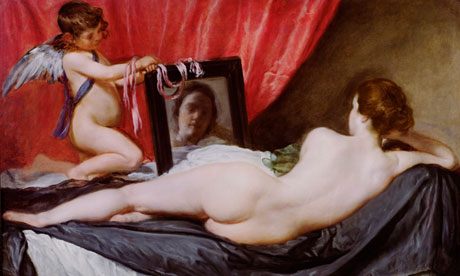
Marie, the narrator of this strange, extravagant, darkly absorbing novel, is possessed by the idea of craquelure. We look at a painting and think the main event is there in the picture, but there's another story to be found in the network of cracks that runs across the surface. The cracks form grids and spirals, nets and spokes, their shapes narrating the physical history of a painting. "Painters create order from disorder," Marie muses, "but the moment that order has been created, the slow march towards disorder begins again." She sees history working its way through the National Gallery, crack by silent crack.
Marie is drawn to quietness, which is why she works as a gallery guard, pacing and sitting, sitting and pacing. A connoisseur of footsteps, she knows that sandals with cork-filled soles make the least noise. The notable points in her day are when she changes rooms, or when a tourist's finger comes close to a canvas. Such moments are electric: the non-touch of that finger might rearrange, imperceptibly, the membrane across a picture. And in any instant the peace of the gallery might be dramatically broken. Marie's great-grandfather was a guard there in 1914 when the suffragette Mary Richardson entered demurely and then suddenly slashed her cleaver through the flesh of Velásquez's Rokeby Venus. Nothing so extraordinary happens under Marie's watch: the novel works too obliquely for that. But Marie is the inheritor of those gashes. She harbours some of the dissident fury that made them, and much of the controlling spirit that guarded against them.
So this is a book about quietness and violence. Carefully curated blandness flares up into spectacle; economy of word and action gives way to melodrama. Marie is a woman who favours self-erasure, loves her grey gallery uniform, courts boredom, avoids risk, prefers not to shine; yet the novel she narrates is an original and assertive performance with more than a hint of the baroque.
These distinctive dynamics are recognisable from Aridjis's much-admired first novel, Book of Clouds, in which a detached young woman spends her time in Berlin typing out someone else's words about the haunted city. Book of Clouds was a collage of the mundane and fantastical, feasting on a vision of Hitler on the U-Bahn in 1986 disguised as an elderly woman. Having surprised us in Berlin, Aridjis surprises us again with her comical and macabre version of London, where goths huddle in nightclub corners "like packed umbrella stands" and a hypnotist might cure your headache while bequeathing you a limp.
"Cra-que-lure … the allure of the crack … the crack of dawn, the crack of doom." There is a Nabokovian rhythm in Asunder's obsessive permutations, and in the novel's dance of fluttering life and slow decay. Marie's flatmate hangs moth-catching strips in every room to preserve her jumpers; Marie unpeels the moths from their sticky graves and places them in miniature landscapes she has crafted from eggshells. They are granted an afterlife of sorts in the bizarre personal museum on Marie's bedroom shelf, where nature is condensed – lacquered, gilded and still cracking. This weird imagery could easily seem precious and overly contrived, but Aridjis is a fine judge of tone. Her eggshell landscapes are both the comical hobby‑craft of a lonely woman and profound exercises in the control of creation and loss.
Obsessed by museums and collections, the novel is itself a museum of motifs displayed in tense juxtaposition. It is the work of an addicted image-maker who fills her cabinet of curiosities and then adds some more. Geology competes with archaeology as the book's structural principle: the injured Rokeby Venus is upstaged for a time by William Dyce's painting Pegwell Bay.
In this London novel, which alternates purposefully between the still air of the National Gallery and the chaotic streets of Camden market, it probably wasn't necessary to include a weekend break at a B&B next to an asylum in an unsavoury cathedral town. And then there comes a whole section in Paris and an outlandish gothic denouement somewhere else again.
Some of these chapters want to become short stories; you can almost see the wires by which they are unwillingly tethered in place. But Aridjis knows all this. Her novel thrills with energy because of it. She dares add one more straining element because she knows that her novel – like the paintings she most admires – will be more intensely alive the more it seems to be just on the verge of falling apart.
• Alexandra Harris's Virginia Woolf is published by Thames & Hudson.

